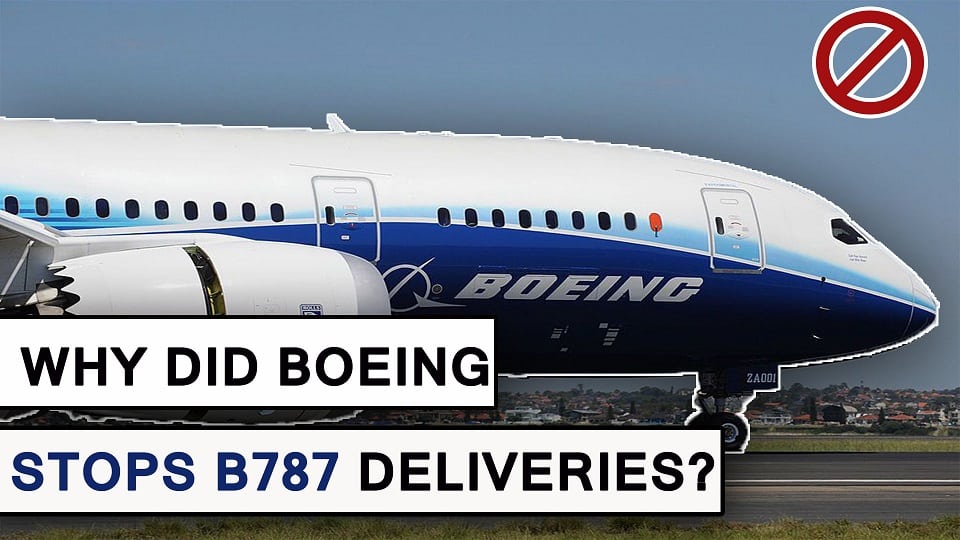Aerospace
How has Boeing’s B787 dreamliner turned into a nightmare?

Most aerospace companies provide the highest quality products due to their extensive knowledge and quality control procedures. Boeing is one of the world’s few corporations that consistently produces high-quality products. However, due to design and manufacturing challenges, Boeing has incurred a large loss in recent years. Quality difficulties have plagued not only Boeing but also Airbus.
However, the company will eventually learn from its errors and make improvements. The aviation licensing authorities, on the other hand, may not allow to make such a mistake again; they inspect the manufacturing system and ensure that they fit all safety criteria. Federal Aviation Administrations, for example, must approve aircraft airworthiness for passenger flights in USA. Manufacture should address all of the issues that have arisen and establish standards.
Boeing has not delivered any new 787 passenger jets to airlines since May 2021, when for a second time safety regulators halted deliveries because they found production flaws in the planes, such as unacceptable gaps between fuselage panels. The FAA had also halted 787 deliveries in late 2020 because of production problems.
Boeing Commercial Airplanes developed and manufactures the Boeing 787 Dreamliner, an American wide-body jet airliner. As of February 2022, there are 1,006 Boeing 787 aircraft in airline service, including 377 787-8s, 568 787-9s, and 61 787-10s, with 481 more aircraft on order. In April of 2022.
Boeing appears to have encountered some difficulties in recent years as a result of several manufacturing issues, which Boeing has resolved. It was recently announced as a result of the COVID shutdown and the 737 Max incident. While Boeing is bearing the brunt of the program’s delays, the impact on client airlines for the type must not be disregarded.
The FAA was called in to address issues involving quality control and the production process. The plane’s self-certification powers have been revoked, and the US government is closely inspecting each undeliverable 787. The manufacturer anticipates significant additional programme expenses as a result of the delays, noting today that
Commercial Airplanes’ first-quarter revenue fell slightly to $4.2 billion, owing to the timing of wide-body deliveries, which was largely offset by greater 737 deliveries. The operating margin of 20.6% incorporates unusual costs and period expenses, such as charges for the effects of the Ukraine conflict and greater research and development costs.
The FAA has advised Boeing to investigate the production system’s operation and any quality issues that may develop throughout the assembly process. The FAA is toughening the restrictions for Boeing after two B737 Max planes crashed owing to a malfunctioning sensor that triggers the controls.
Allegiant Air Orders Up to 100 737 MAX Jets
The FAA indicated in a statement that if Boeing is eventually authorized to resume 787 deliveries, “Airworthiness certificates for all Boeing 787 Dreamliner’s will continue to be issued by the FAA. The agency will be able to assess the effectiveness of Boeing’s efforts to improve the 787 manufacturing process.”
Manufacturing is a key phase for any product because even the tiniest mistake will be repeated across the board. If it is reported early enough, future reworks can be avoided.
According to the FAA letter, small cracks in the construction surrounding the passenger and cargo doors in the aft fuselage part were also identified.
China may lift the ban on B737 MAX aircraft if certain conditions are met.
This is yet another example of tiny gaps discovered during final assembly in the plane’s structure, which have previously been discovered at major fuselage section joins and the forward pressure bulkhead, a dome-shaped structural barrier behind the plane’s nose that is critical to maintaining air pressure within the cockpit and passenger cabin.
Such gaps, which can also occur in metal aero planes, are frequently filled with little pieces of material called shims during assembly. However, during the building of the plane pieces, Boeing suppliers curiously disregarded the gaps.
These components will be obtained from the Leonardo company in Italy. Previously, the FAA alerted the supplier and advised mechanics to verify their own work when assembling the structures, with little or no oversight from quality inspectors.
Boeing evaluating the production rate of B737 max to 31 per month by end of 2022.
More than 1,000 planes are now in the air, according to the memo, and the FAA is concerned about the lack of detailed assembly data on each plane. Boeing submitted its inspection plan, claiming that it would not require FAA approval.
Issues with the lithium-ion batteries hampered early operations, resulting in onboard fires. In January 2013, the US FAA grounded all 787s until the updated battery design was certified in April 2013. There have been no fatalities or hull damage on the 787 as of January 2022. 72 clients had placed orders for 1,510 787 aircraft as of March 2020.
Boeing claims that some titanium 787 parts were unstandardized made over the previous three years, adding to a long list of concerns with the wide-body aeroplane. Two ANA flights had to ground until the problem could be fixed.
July 2022 Boeing release video and showing that how they working for fixing an Fuselage gap and demonstrated that Boeing 787 is safe aircraft and it can be airworthy . Video
Boeing expanded 737 MAX production and deliveries while also submitting a certification plan to the FAA for the 787. Despite the pressures on Boeing’s defense and commercial development programmes, the company is on schedule to create positive cash flow in 2022, and they are concentrating on our performance as they work through certification requirements and bring several major products to production. Leading with safety and quality, they are taking the necessary steps to ensure operational stability, meet customer obligations, and position Boeing for a long-term future.”
Since late 2020, Boeing has nearly completed the global safe return to service of the 737 MAX, with the fleet having flown over one million cumulative flight hours. The 737’s output rate continues to rise, with 31 planes projected to be delivered per month in the second quarter.
The business has submitted the certification plan for the 787 to the FAA. The initial planes have been reworked, and the company is working closely with the FAA to determine when deliveries will resume. The programme is now generating at a very low pace and will do so until deliveries restart, with a gradual return to five per month envisaged over time. The business continues to expect 787 extraordinary expenses of $2 billion, the majority of which will be incurred by the end of 2023, including $312 million in the first quarter.
Boeing has postponed the debut of the B777x aircraft until 2025 due to continuous issues and the suspension of the B787. However, in order to ensure steady deliveries this year, it has increased production rates for the Boeing 737 MAX.
In the comments section below, tell us what you think about the Boeing 787 aircraft troubles.

Aerospace
Which is bigger 777x or 787 aircraft ?

The 777X is a new series of the Boeing 777 family and is designed to be larger and more efficient than its predecessor. It features two variants: the 777-8 and the 777-9, being the larger of the two.
The Boeing 777X emerges as the larger sibling within the Boeing family, representing a significant leap forward in both size and efficiency. Comprising two variants, the 777-8 and the 777-9, the latter takes the crown as the larger of the two. With its expansive fuselage and impressive wingspan, the 777X is tailored for long-range journeys and boasts a substantial passenger capacity.
On the other hand, the Boeing 787, affectionately known as the Dreamliner, occupies a niche in the market as a smaller yet formidable aircraft designed for medium to long-range flights. Its distinguishing feature lies in its composite fuselage, a technological marvel that renders it lighter and more fuel-efficient compared to conventional aluminum counterparts. The Boeing 777X is larger than the Boeing 787 aircraft.
When it comes to passenger capacity, the 777-9 reigns supreme, typically accommodating a sizeable contingent of 400-425 passengers in its standard configuration. In contrast, the 787, with its more modest dimensions, typically carries between 240-290 passengers, depending on the variant and layout.
One of the remarkable innovations introduced with the 777X is its folding wingtips, a feature designed to address the logistical challenges of accommodating such a large aircraft in conventional airport gates. These folding wingtips enable the 777X to retract its wings, allowing it to fit into gates designed for smaller aircraft while still reaping the benefits of an extended wingspan during flight, thereby enhancing fuel efficiency and operational flexibility
Aerospace
China Secures Production Certificate for Mass Production of Pilotless eVTOL Aircraft

The first passenger-carrying pilotless electric vertical takeoff and landing (eVTOL) aircraft in the world, the EH216-S, has received the Production Certificate for its eVTOL aircraft from the Civil Aviation Administration of China (CAAC).
This is a significant milestone for EHang Holdings Limited, the leading UAM technology platform company in the world. This outstanding accomplishment is another big step towards mass manufacturing for the eVTOL aircraft and the ensuing commercial operations, building on the ground-breaking acquisition of the Type Certificate and the Standard Airworthiness Certificate for the EH216-S.
The PC is a crucial certificate that the aircraft maker receives from the CAAC, the country’s aviation authority. By obtaining this certificate, EHang has demonstrated that it has set up a quality management system for mass production that satisfies the airworthiness regulation standards set forth by the CAAC, and the company has been given permission to continue producing mass quantities.
It is also a strong guarantee of the calibre of the goods made by EHang. Raw materials, supplier management, manufacturing organisation, production quality control, aircraft pre-delivery test, after-sales repair and maintenance, etc. are all included in the mass production quality management system for the EH216-S.
To ensure that every aircraft and its components that roll off the production line strictly adhere to the approved type design and safety requirements, the system sets clear guidelines and documentation for every step in the production procedure. This ensures comprehensive traceability and safety control.
Aerospace
Four Airbus A380 Superjumbos lined up to be scrapped

In a strategic move aimed at reclaiming valuable resources from the iconic Airbus A380 aircraft, VAS Aero Services and Dr. Peters Group have announced a significant collaboration.
This partnership marks a milestone in aviation logistics and aftermarket services, with four of these colossal planes slated for teardown and redistribution of used serviceable material (USM).
The venture between VAS Aero Services, renowned for its expertise in aircraft dismantlement, and Dr. Peters Group, a prominent Germany-based investment fund management firm, underscores a commitment to sustainable aviation practices. This isn’t their first foray into scrapping A380s; their successful partnership has already seen the dismantlement of these aircraft, making them pioneers in this niche.
Under the agreement, the latest consignment brings the tally to eight A380s entrusted to VAS by Dr. Peters Group. Managing Director Christian Mailly of Dr. Peters Group emphasized the trust placed in VAS, citing their unparalleled capabilities in dismantlement and aftermarket sales network. It’s a strategic move in response to the growing demand for quality USM parts, particularly with the resurgence in reliance on the A380.
Notably, the teardown process will be carried out at various locations, optimizing the positioning of harvested parts to cater to different markets. While some parts will be positioned in Europe to support operators in the region and the Middle East, others will remain in the Asia-Pacific region. This meticulous strategy ensures efficient access to spare parts, benefiting MROs and airlines across these markets.
The decision to retire these A380s comes at a time when operators are reassessing fleet strategies amidst evolving market dynamics. Despite initial plans for quick retirement due to the emergence of more fuel-efficient alternatives, factors such as a rebound in long-haul demand and delays in new widebody deliveries have prompted operators to reconsider. The A380, with its unique capacity and capabilities, presents a practical solution for short-term capacity management.




























